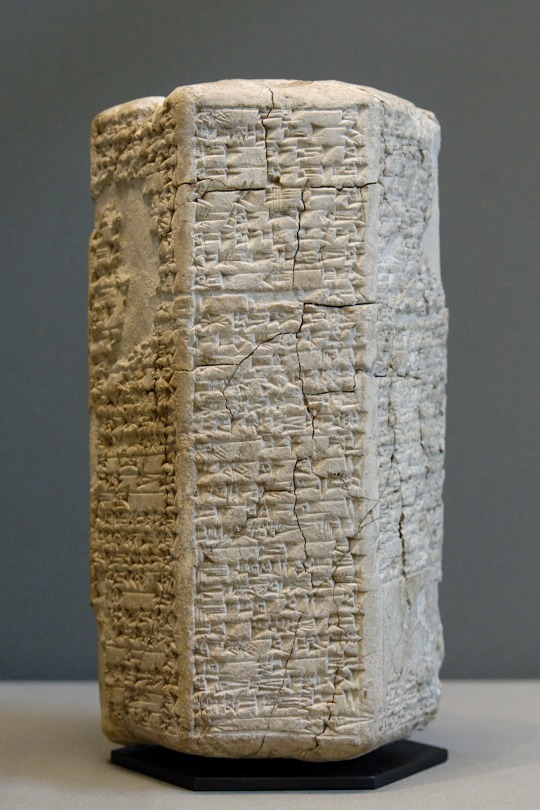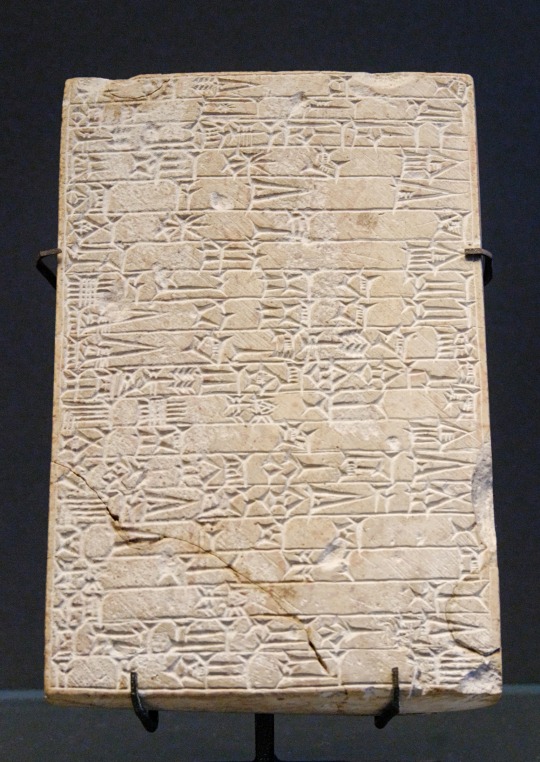#ishbi-erra
Photo

Sumerian Mythology - The earliest deities of ancient Mesopotamia (62)
The Lament for Sumer and Ur – The last king of the Ur III dynasty
Ibbi Sin (reigned 2028 BC - 2004 BC) was the fifth and last king of the Third Dynasty of Ur. His reign was plagued by internal and external troubles, which eventually led to the downfall of the Ur III dynasty. His name means "he who is called by the god Sin [Ref]".
During his reign, the Sumerian empire was attacked repeatedly by Amorites. As faith in Ibbi-Sin's leadership failed, Elam declared its independence and began to raid as well. Ibbi-Sin ordered fortifications built at the important cities of Ur and Nippur, but these efforts were not enough to stop the raids or keep the empire unified. Cities throughout Ibbi-Sin's empire fell away from a king who could not protect them, notably Isin under the Amorite ruler Ishbi-Erra. Ibbi-Sin was, by the end of his kingship, left with only the city of Ur. In 1940 BCE, the Elamites, along with "tribesmen from the region of Shimashki in the Zagros Mountains" sacked Ur and took Ibbi-Sin captive; he was taken to the city of Elam where he was imprisoned and, at an unknown date, died.

シュメール神話~古代メソポタミア最古の神々(62)
シュメールとウルの滅亡哀歌〜ウル第3王朝の最後の王
イビ・シン(Ibbi Sin、在位:紀元前2028年 - 紀元前2004年)は、ウル第3王朝の第5代にして最後の王である。彼の治世は内憂外患に悩まされ、ついにウル第3王朝は滅亡することとなった。名前は「シン神(参照)に呼ばれたる人」の意。
彼の在位中、シュメール帝国はアモリ人に何度も襲われた。イビシンの指導力に対する信頼が失われると、エラムが独立を宣言し、同様に襲撃を開始した。イビ・シンは重要な都市であるウルやニップールに要塞を築くように命じたが、それだけでは襲撃を食い止めることはできず、帝国を統一することもできなかった。イビ・シンの帝国内の都市は、守れない王のために衰退し、特にイシン市はアモリ人の支配者イシュビ・エッラの配下に置かれた。イビ・シンの王の任期が終わる頃には、ウルの都市だけが残った。紀元前1940年、エラム人と「ザグロス山脈のシマシキ地方の部族」がウルを略奪し、イビ・シンは捕らえられ、エラムの町に連れて行かれて投獄され、死亡したが年代は不詳。
#ibbi-sin#the last king#the Ur III dynasty#sumerian mythology#sumerian gods#ancient mesopotamia#mythology#legend#folklore#nature#art
68 notes
·
View notes
Text
Ur III period callout post
Ishbi-Erra of Isin is not a true LUGAL but a feeble rebellious ENSI. He is a man of Mari and a traveling rubbish salesman of non-Sumerian origin.
Beware his new temple, fellow citizens of Ur, there are problematic imports inside like Dagan of Tuttul and Ishara of Ebla. Nothing wrong with these if they stay in the Upper Land but this is no place for them
-Ibbi-Sin of Ur
9 notes
·
View notes
Photo

Hymn to Iddin-Dagan of Isin (c. 1950 BC).
During the dynasties of Isin and Larsa, hymns exalting the king were common. This text is written in Sumerian, and is probably a school document.
“To Iddin-Dagan, [the god] Anu decreed a great fate...to the pastorate of the country he raised him, [the god] Enlil looked at him favourably...O Iddin-Dagan, who is like you?”
The Isin-Larsa period (c. 2025 – 1763 BC) followed the Ur III Period, which had ended with the Elamite invasion of 2004 BC. During this time, life was unstable, and non-Sumerian invasions were common. The dynasties of Isin and Larsa were vying for dominance, with Larsa eventually winning out.
During the reign of Ibbi-Sin (the last king of the Ur III Period), the governmental official Ishbi-Erra moved from Ur to Isin and established himself there as a ruler, beginning the Dynasty of Isin. He defeated Ibbi-Sin in battle, and although he wasn't able to expel the Elamite invaders, he did manage to drive them out from the Ur region. The Dynasty of Isin thus had control over Ur, Uruk and Nippur (cities of cultural significance) and flourished for over 100 years.
But Gungunum of Larsa (c. 1932 – 1906 BC) captured Ur during his reign, and Isin lost an important city and trade route. The next two kings of Larsa cut Isin completely off from canals, and so Isin declined rapidly. The usurper Enlil-bani seized power in c. 1860 BC, and Isin lost Nippur at some point as well. The Dynasty of Larsa eclipsed Isin in power and control of the region.
#history#military history#politics#economics#trade#languages#isin-larsa period#dynasty of isin#dynasty of larsa#mesopotamia#sumer#isin#larsa#ur#uruk#nippur#iraq#al-qādisiyah governorate#iddin-dagan#ibbi-sin#ishbi-erra#gungunum#enlil-bani#sumerian language#cuneiform#sumerian cuneiform
61 notes
·
View notes
Photo

Foundation tablet of the temple of Ninisina, dedicated by Warad-Sin, king of Larsa (c. 1830 BC).
Warad-Sin was King of Larsa during the Isin-Larsa period, reigning from 1834 – 1822 BC. This was after the fall of Ur at the hands of the Elamites, and life was often unstable, with many non-Sumerian invasions. The Dynasty of Isin rose to power under Ishbi-Erra (c. 2017 – 1984 BC), but Larsa eventually prevailed as the dominant Sumerian city-state.
Larsa had been subject to the ciy of Lagash, but when Ishbi-Erra captured that city, Larsa became subject to Isin instead. The rulers of Isin appointed governors to rule over Larsa, and out of those governors the Dynasty of Larsa began.
But by the time of Warad-Sin, the fortunes of Larsa were nearing an end. Hammurabi, the first major ruler of the First Babylonian Dynasty, defeated Larsa in 1763, and united the whole region. Larsa became a minor site after this defeat.
#history#military history#politics#languages#isin-larsa period#dynasty of larsa#dynasty of isin#first babylonian dynasty#mesopotamia#sumer#old babylonian empire#larsa#isin#babylon#iraq#warad-sin#hammurabi#ninsun#cuneiform
35 notes
·
View notes